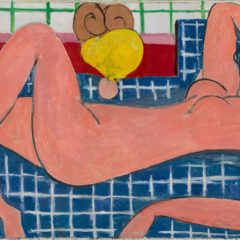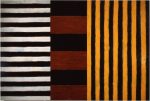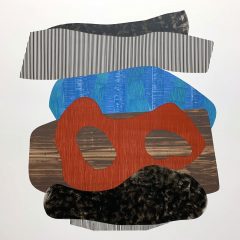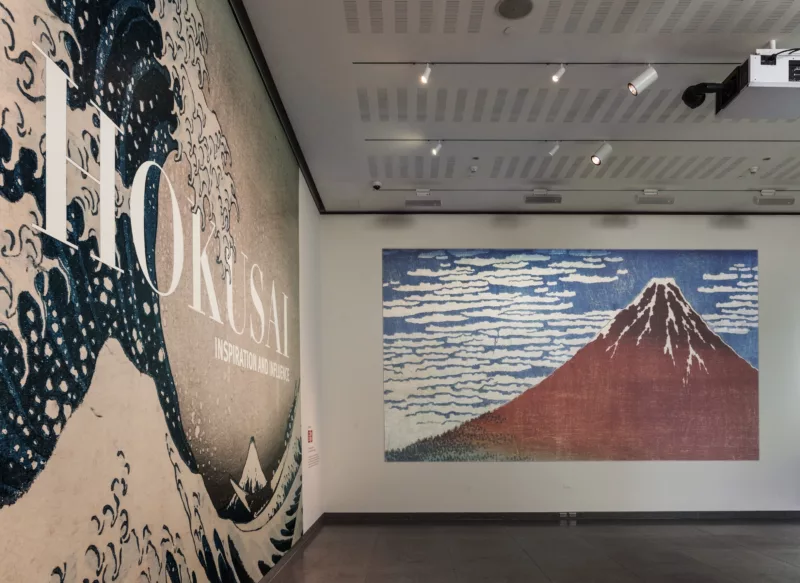
Hokusai: Inspiration and Influences at the Museum of Fine Arts, Boston (through July 16, 2023), then traveling to the Seattle Art Museum (October 19, 2023 through January 21, 2024,) is that unicorn sought by museums everywhere: an exhibition with something for everyone, from scholars of Japanese art to families out for a day’s cultural entertainment. The crowds on the Sunday I saw the exhibition made that abundantly clear. Katsushika Hokusai (1760 – 1849) wanted to be a painter, and the exhibition includes paintings, both finely-colored and in ink. But the less-elevated media of printmaking and book illustrations supported him and made him the most famous, as well as the most imitated, of Japanese artists.
It is worth remembering that, unlike the vast majority of work in the MFA’s collection, Hokusai’s prints were not made for the wealthy and powerful. They were low-cost images made for a general public; one print on view was an advertisement for women’s cosmetic powder, and artists’ commercial work is rarely on display in museums. The exhibition appropriately includes Hokusai’s influence not only on high art in Japan and the West, but also on the world of popular material culture in which the prints originally circulated.
In addition to luxury decorative objects made during the nineteenth-century fashion for Japonisme, the exhibition includes a version of Hokusai’s “Under the Wave off Kanagawa,” (commonly known as the “Great Wave”) constructed in Lego, a photograph of the Japanese ice skater Yuzuru Hanyu in a designer costume with sleeves that ripple in Hokusai-like waves, and contemporary manga. Incorporating this range of influence is certainly one reason for the exhibition’s broad appeal, but it also reminds us that the division between art and popular culture has porous margins, and also that artworks shown in museums have had changing meanings through time and across cultures.
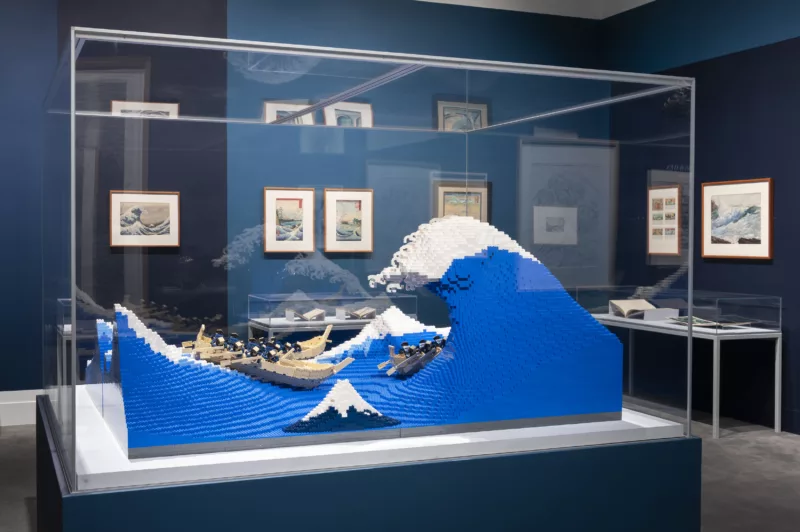
Hokusai didn’t realize his ambition to illustrate “The Great Picture Book of Everything,” but the exhibition includes one book of his sketches for the project. If he didn’t draw everything, his subjects reveal the breadth of his interests and ability to bring life and visual interest to the most mundane and conventional material: beautiful women, characters from history and literature, sumo wrestlers, craftsmen at work, children playing, warriors, deities, brothel interiors, still lives, battle scenes, shipwrecks, rural agriculture, urban and rural landscapes, flowers, marine creatures, and unforgettable monsters and ghosts.These last deserve much more attention that I have room for; Hokusai may be the only great artist to excel at these subjects. Hokusai’s students published ten volumes of images from his sketchbooks, and publishers assembled five further volumes posthumously, all of which went through numerous editions. The sketchbooks became his first runaway success, appreciated by the general public as well as by artists in Japan and elsewhere. The exhibition includes French dinnerware with fish and bird patterns lifted directly from the first volume of the sketchbooks to reach France.
The exhibition begins with an overview of artists’ education during 18th-19th century Japan. It includes work by Hokusai’s teacher, Katsukawa Shunshō, and his numerous students, including his youngest daughter, Katsushika Ōi. One theme that will interest knowledgeable visitors is the incorporation of the Western method of depicting receding space using single-point perspective within the very different conventions of Chinese and Japanese art. They will also appreciate the range of work by his students, competitors and admirers, including Utagawa Hiroshige and Utagawa Kuniyoshi. There is a great range of paintings, drawings, popular prints, illustrated books, and the virtuosic Surimono prints, which often included embossing and highlights of gold; they were more elaborate than popular prints because entire editions were commissioned privately.
The second theme explored is Hokusai’s place in Japonisme, the fashion for Japanese subjects and motifs in mid-nineteenth-century Europe and the United States. Among the decorative arts on view are a fan-shaped vase designed by Frederick C. Carter for Steuben which interprets Hokusai’s waves in iridescent blown glass, and a stained glass window by John La Farge. A very showy inkstand by Bucheron after a design by Paul Legrand employs cloisonné enamels on partial-gilt silver to imitate the highly-detailed decoration of Kutani porcelain, and one of the bowls depicted cites Hokusai’s view of fishermen with Mt. Fuji in the background. It is a far cry from the print’s original, middle class audience, and the conceit of representing the less valuable material of porcelain in enamel on silver is either the height of conspicuous consumption, or a wealthy connoisseur’s joke.
The long tail of Hokusai’s influence on artists began with Japonisme and continues to the present day, and the exhibition has assembled a most surprising grouping that cuts across styles, media and subjects. Some artists picked up on the exoticism of figures in Japanese dress, but many more learned from the manner in which Hokusai and his cohort sited images on a page. The first generation of painters who had to deal with the entirely new spacial representation produced by photography were attracted to works in which the frame cut off part of the subject, acknowledging that the image was an excerpt of a larger field. Works by Claude Monet and Édouard Vuillard were no surprise. But I didn’t expect the woodcut of a fisherman by Gauguin.
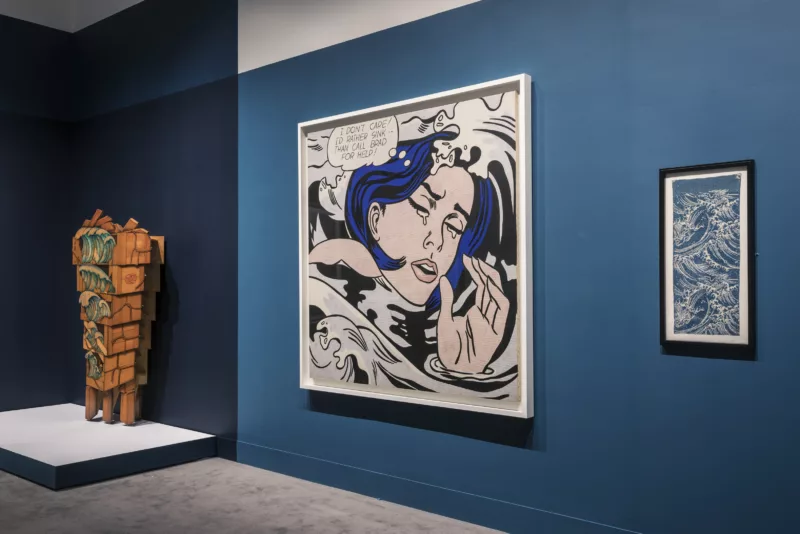
One room displays Hokusai’s iconic “Great Wave” and works it inspired, including the aforementioned Lego version by Jumpei Mitsui, a chest of drawers by John Cederquist,
Roy Lichtenstein’s painting,“Girl Drowning,” Linda Benglis’s tabletop-size ceramic “Palladium Wave” and a drawing by Andy Warhol. It was easy to overlook the small woodcut that provoked those and endless other versions. But the print itself is a marvel – I don’t think I’d ever seen it. It is essentially monochrome – more blue than one could imagine, and at close range the three fish delivery boats overwhelmed by the waves turn Hokusai’s unforgettable image of the power of the sea into a poignant, human story.
Recent citations and homages to Hokusai’s work were surprising and delightful: prints after the “great Wave” by Yoshitomo Nara and Christiane Baumgartner, multicolor woodcuts by Helen Frankenthaler, Yayoi Kusama and Francesco Clemente, Judith Schaechter’s stained-glass triptych, “Dream of the Fisherman’s Wife,” Arthur Tress’s diamond-shaped photographs of Morro Rock, a poster for the animated film, “Demon Slayer: Mugen Train,” and several recent manga. Three artists demonstrated that Hokusai’s imagery can successfully expand to a very large scale: Annabeth Rosen’s “Wave” opened the exhibition with a more than six foot surging form in multipart ceramic, Taiko Chandler interpreted a small woodcut as a wall-size relief made with printed Tyvek, and Linda Sormin’s mixed-media installation filled half of a gallery.
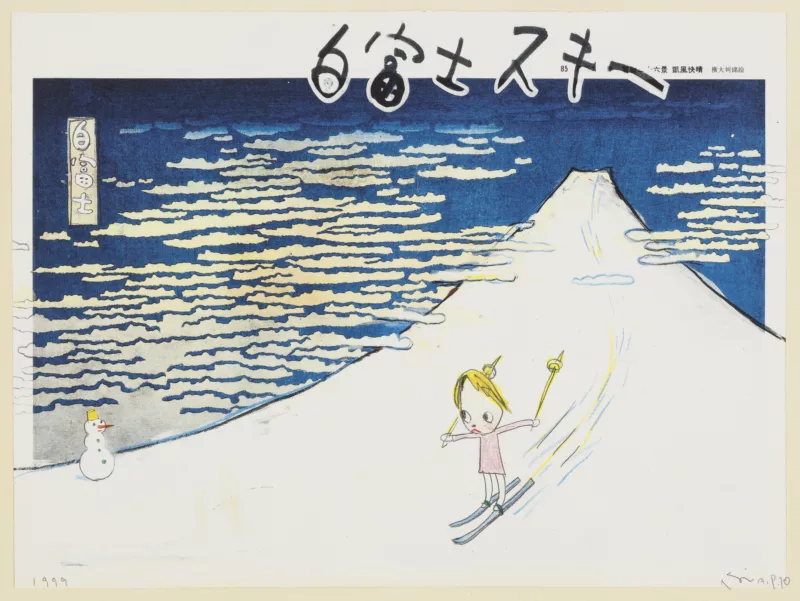
The exhibition is very large and has substantial labels for most of the work on view. Normally I’d deplore that much written material, which no one could read during the usual visit. But most of the visitors were wiser than the present writer –who learned a great deal and enjoyed it over an extended visit — and only looked at the interpretative material for the items that specifically interested them, which seemed to serve the audience well.


